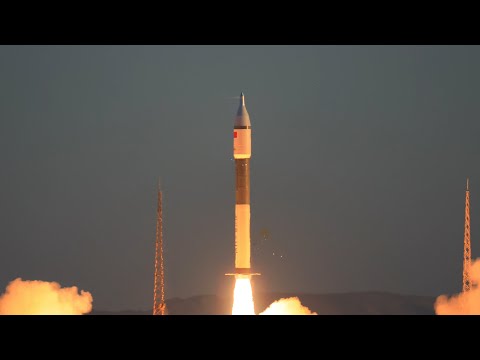Now Reading: Department of War Executive Order should prioritize readiness against space stalkers
-
01
Department of War Executive Order should prioritize readiness against space stalkers
Department of War Executive Order should prioritize readiness against space stalkers


The administration has yet to follow up on its 200th Executive Order, which called for enhanced readiness. This silence represents a profound missed opportunity. Amidst a severe, persistent partisan divide, focusing on genuine military readiness offers a pathway for non-partisan decisions. To ensure this initiative cost-effectively achieves its goal of preparing for war so as to keep peace—not just for the United States but the free world—the administration must channel the Executive Order’s mandate into tangible action, starting with what I consider to be the most urgent threat: readiness against space stalkers, or spacecraft that can approach and attack satellites in orbit.
Thus far, the administration’s public argument has been focused on a politically charged but secondary issue, namely that the order will restore the warrior ethos, maximize lethality, not tepid lethality and change what the administration called a “woke” DoD. While this rhetoric satisfies its political base, it risks hardening Democrats’ opposition to the entire initiative. If the administration does not redirect, the long-term fate of this critical national security initiative beyond 2028 may ultimately depend more on partisan politics and which party controls the White House than on the readiness priorities themselves.
By deliberately recalling President George Washington’s 1790 address —“To be prepared for war is one of the most effective means of preserving peace” — the order, in effect, delivers a clear, uncompromising mandate: Unmatched power does not automatically guarantee adequate readiness. But true military readiness doesn’t come from renaming government institutions. True readiness requires us to understand the nature and characteristics of specific threats and tailor our defensive and deterrent resources to meet those threats in a timely and effective manner.
A readiness-focused project, championed by both sides, is the perfect vehicle for this reframing. The immediate priority must now be to help the administration select its first readiness project. This project should demonstrate the initiative’s potential to cost-effectively produce timely and effective readiness against existing and future threats in all operational domains: land, sea, air, cyber and space.
This strategic selection of an exemplary project should highlight a decades-old deficiency in our military’s preparedness for modern war, which is most acute in space. This domain is rapidly and unavoidably entering an era of irreversible weaponization, driven by dual-use technologies. Among the space threats, the “space stalking threat” about which I’ve written multiple articles is the most urgent and consequential danger to our critical satellites, a danger likely to materialize within the next five years. Showcasing readiness against this specific threat makes a credible case for prioritizing military readiness by highlighting the relatively low cost and the high benefit of protecting our satellites.
While Gen. B. Chance Saltzman, U.S. Space Force Chief of Space Operations, has proactively recognized this danger and pioneered necessary programs in the last three years, we remain far behind China’s persistent development of stalker swarms over the last 17 years. To win this critical threat-and-readiness race, the U.S. requires more than a spirited start; it demands a clear understanding of the specific needs for readiness in this new era of weaponized space, and a bold prioritization of our talent and resources. Fortunately, the new Executive Order provides the necessary symbolic and ideological propellant to place space readiness squarely at the forefront for timely development and deployment.
As Gen. Saltzman has guided the Space Force to carry out significant work under both the Biden and Trump administrations, his efforts demonstrate the importance and bipartisan nature of space readiness in general. This focus on unmatched readiness in space is the most likely path to bring Democrats and Republicans together, setting a precedent for preparedness across all domains.
Moreover, the White House leadership is likely to support putting readiness against the space stalking threat to the forefront. They are certainly aware that Chinese President Xi Jinping has ordered the Chinese military to accelerate the attainment of the operational capability to seize Taiwan by force by 2027. Also, they likely know that China’s space stalkers could be used as a precursor attack that could disable U.S. satellites, which provide critical support to military, commercial and civil operations during peacetime, crisis and wartime. The mere threat of such an attack could be enough to deter the U.S. from intervening to save Taiwan. Furthermore, these same space stalkers could destroy the Golden Dome during its formative years, underscoring the urgency of getting ready against this stalking threat.
In March, then-Vice Chief of Space Operations Gen. Michael Guetlein warned that late 2023 and December 2024 five Chinese satellites practiced “dogfighting” in space. If we do not accelerate our preparedness, even rudimentary swarms with about 200 space stalkers — likely ready within the next five years — could be adequate to disable about 100 of our poorly-protected critical satellites. This degradation of our space support would be so profound that China could follow with a sea blockade or full-force invasion to seize Taiwan. As I previously calculated, the cost for establishing readiness against such a swarm is about $10 billion, a relatively low amount that is well worth the investment. This expenditure represents a critical insurance premium for the free world, protecting against a potential political disaster, as well as economic losses in the trillions of dollars.
Embracing the bodyguard spacecraft: The only timely defense
Since the space stalking threat is likely to be effective against our inadequately-protected satellites sometime within the next five years, using bodyguard spacecraft to protect our satellites is likely to be the only stalker defense that can be ready in a timely manner and in a non-escalatory way.
However, currently, U.S. government officials and even its contractors tend not to use “bodyguard” to describe that dual-use spacecraft capable of rendezvous proximity operations (RPO) can be used for protecting vulnerable satellites. They believe the term is too offensive sounding, as a bodyguard can be repurposed for attacking adversaries’ peaceful satellites. In April 2025, Gen. Stephen Whiting, commander of U.S. Space Command, said that the U.S. “is stepping up its own development of dual-use technologies — tools that… may also be used to disable or disrupt enemy systems.” Clearly, there is no need to hide that this type of spacecraft can be used as a bodyguard spacecraft to disable space stalkers and to perform close inspection of an adversary’s potentially offensive satellites.
Toward readiness in space for the free world
Currently, many U.S. companies such as Northrop Grumman, Astroscale, Impulse Space, Anduril, True Anomaly, Maxar Technologies, Lockheed Martin and Boeing, are developing dual-use spacecraft or technologies for RPO, all of which are essential for the development of bodyguards. Other friendly countries or organizations such as the European Union, France, the UK, Japan, Australia and India are working on RPO technologies or bodyguard spacecraft. Unlike the U.S., they openly use this term. Furthermore, France, the U.K., and Australia have cooperative programs with the U.S. The U.S. should increase cooperation with all its allies and partners on all aspects of space readiness. An alliance for space resilience in the free world sends an unmistakable message to our adversaries: Keeping peace in space and on Earth requires readiness for war in space.
It is important to be aware that, as the U.S. is rapidly moving toward timely and adequate readiness, China is unlikely to abandon its ability to attack on our critical satellites that it has meticulously planned for two decades. It could instead speed up its stalker swarm development as fast as possible and launch it before our window of vulnerability in space closes, hoping the damage to our satellites is enough for them to capture Taiwan. This high-stakes scenario demands two immediate and parallel courses of action: first, the rapid acceleration of our preparedness; and second, a unified demonstration of allied resolve to defend Taiwan and protect the free world.
Supervision of readiness projects
The supervision should be a collaborative effort led by Secretary Hegseth (Secretary of War), Gen. Saltzman (Space Force), and Gen. Guetlein (Golden Dome Initiative), or their respective designees. These officials have a significant, vested interest in the successful execution of such projects. The three basic elements outlined below are essential for ensuring these projects produce verifiable and impactful findings. Furthermore, the proposed project on readiness against stalking will serve to illustrate the application of these foundational methodological elements for subsequent projects.
- Defining threat and describing readiness requirements: Specify the nature and characteristics of China’s space stalkers as a function of time over the next five years. Establish clear metrics for timely and adequate readiness that are commensurate with the growth of that stalking threat, while acknowledging the inherent uncertainties in both the threat and our preparedness.
- Describing the Concept of Operations (CONOPS): Specify the concept of operations of the defensive system for readiness. In the case of bodyguard spacecraft, one or more bodyguards should be pre-stationed near an otherwise vulnerable but critical satellite. Crucially, the U.S. should declare, in peacetime, a clearly defined “Space Self-Defense Zone” with a defined radius or altitude around each satellite that needs to be protected at all times.
- Employing an accredited cost-benefit analysis: This project has a highly favorable benefit-to-cost ratio in: (a) maintaining stability in space; (b) protecting the Golden Dome over the next five years with the option of continuing to upgrade the readiness commensurate with the growing sophistication of stalker swarms; and (c) setting an exemplary approach for readiness against other geopolitical and technological threats in all domains.
President Trump’s “Department of War” Executive Order strategically re-focuses the nation on readiness, emphasizing the critical need for both timeliness and adequacy. This focus now provides the political and strategic leverage needed to secure bipartisan support for genuine military readiness. By channeling the symbolic power of the Department of War into a concrete, low-cost, high-benefit defense project against the space stalking threat, the administration can move the debate away from polarizing culture wars. This is necessary to catch up with China’s stalking capability, which is rapidly moving toward its effective use within the next five years. In sum, the Department of War, joined by the Space Force and the Golden Dome Initiative, should be more than happy to pay the $10 billion premium for insuring against political catastrophe and potential economic damages in the trillions of dollars — a disaster for not only Taiwan and the U.S. but the entire free world.
Brian G. Chow is an independent policy analyst with more than 190 publications, including numerous monographs, on space and other national security issues. He is a former Senior Physical Scientist at the RAND Corporation, a role he held for 25 years. In addition to providing routine consulting services to government agencies through RAND, he was independently appointed as a consultant to the Office of the Chief of Naval Operations, the President’s Science Advisor and the Under Secretary of Defense for Policy at different times, advising them on specific high-level initiatives. He holds a Ph.D. in physics, an MBA with distinction, and a Ph.D. in finance.
SpaceNews is committed to publishing our community’s diverse perspectives. Whether you’re an academic, executive, engineer or even just a concerned citizen of the cosmos, send your arguments and viewpoints to opinion@spacenews.com to be considered for publication online or in our next magazine. The perspectives shared in these opinion articles are solely those of the authors.
Stay Informed With the Latest & Most Important News
Previous Post
Next Post
-
 012024 in Review: Highlights from NASA in Silicon Valley
012024 in Review: Highlights from NASA in Silicon Valley -
 02Panasonic Leica Summilux DG 15mm f/1.7 ASPH review
02Panasonic Leica Summilux DG 15mm f/1.7 ASPH review -
 03From Polymerization-Enabled Folding and Assembly to Chemical Evolution: Key Processes for Emergence of Functional Polymers in the Origin of Life
03From Polymerization-Enabled Folding and Assembly to Chemical Evolution: Key Processes for Emergence of Functional Polymers in the Origin of Life -
 04How New NASA, India Earth Satellite NISAR Will See Earth
04How New NASA, India Earth Satellite NISAR Will See Earth -
 05And Thus Begins A New Year For Life On Earth
05And Thus Begins A New Year For Life On Earth -
 06Astronomy Activation Ambassadors: A New Era
06Astronomy Activation Ambassadors: A New Era -
07SpaceX launch surge helps set new global launch record in 2024




















